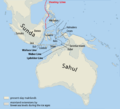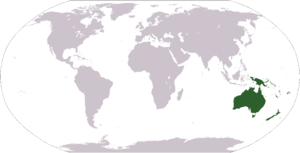Australasia
Australasia (south of Asia) broadly refers to the region around Australia, New Zealand, New Guinea and the surrounding islands of Melanesia, occasionally also parts of Indonesia. The term was coined in 1756 by Charles de Brosses to distinguish it from Polynesia and Magellanica.
Politically and culturally, the designation is rather inconvenient, because although Australia and New Zealand are similar from a sociological point of view, the other states in the region have completely different conditions. From a geographical point of view, the term makes more sense, since the region has many similarities, for example, marsupials. In this sense, the Wallace Line forms the border with Asia; to the west lie the islands of Bali and Borneo, which belong to Asia, while to the east Lombok and Sulawesi already belong to Australasia.
Biogeographically, the term Australasia is more narrowly defined: Here it includes the areas that were connected to Australia via land bridges during the last ice ages, i.e. Tasmania, New Guinea and some smaller islands off Australia, but not New Zealand and New Caledonia.
· 
Australasian Bioregion
· 
Sunda and Sahul
· 
The males flora region
· 
Wallacea

Australasia Olympic Flag

Australasia
Sports
→ Main article: Australasian Olympic history
In sport, the name Australasia was used for the two states of Australia and New Zealand, which are closely related politically and culturally. The two countries competed with joint teams under this name at the 1908 and 1912 Olympic Games and in the Davis Cup from 1905 to 1912.
See also
![]()
Commons: Australasia - Collection of images, videos and audio files
- Australasian Mediterranean Sea in the area of the Malay Archipelago
Search within the encyclopedia